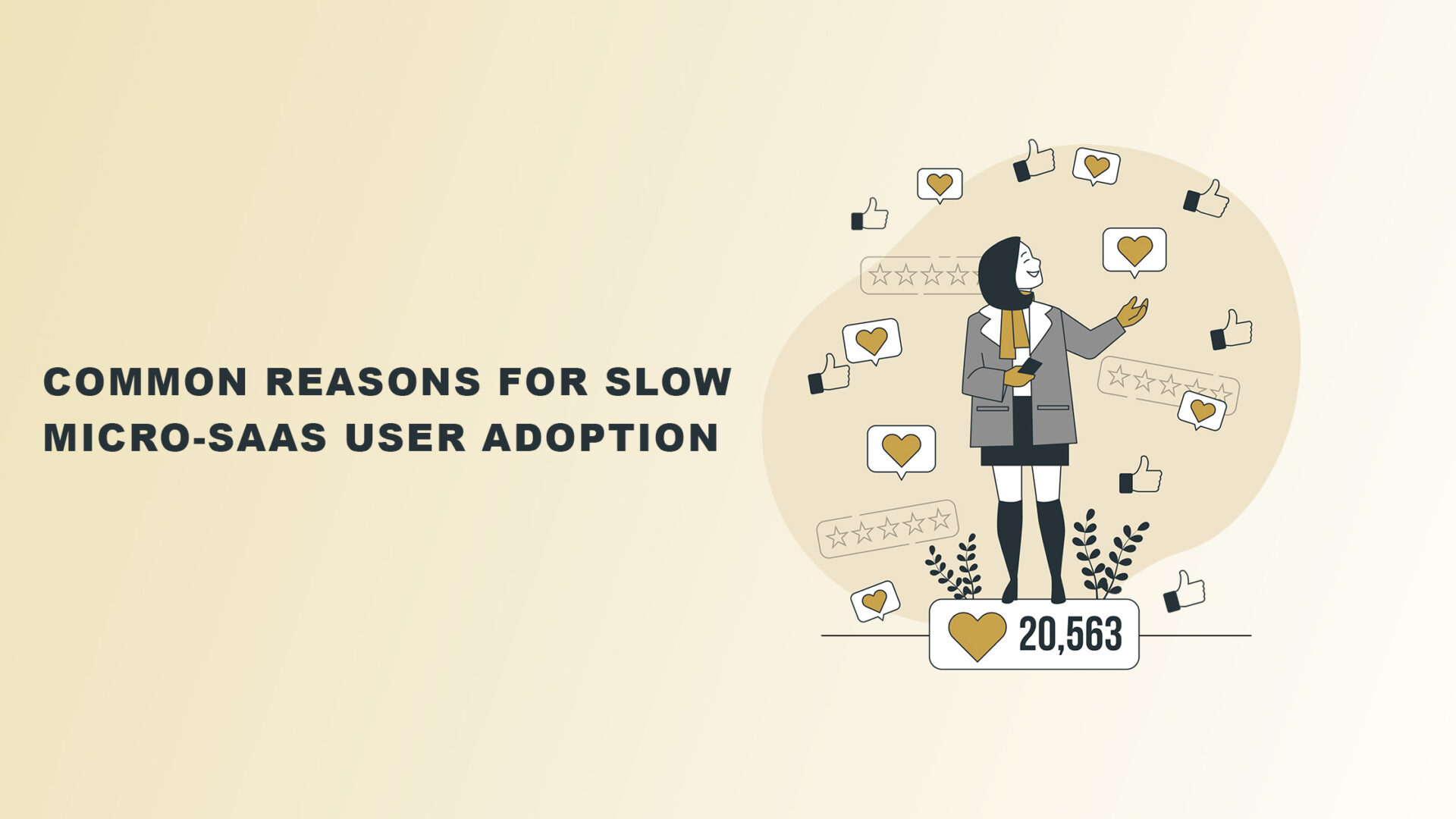Micro-SaaS users drive the market, which is why slow user adoption can seriously harm your business.
After all, user adoption rates are directly tied to churn, which you want to ensure is as low as possible so you can turn a profit.
However, micro-SaaS is different from regular SaaS, and the reasons behind low user adoption rates can also vary.
To optimize your adoption rates and build a good income from recurring monthly payments, you should follow the best practices for marketing micro-SaaS companies.
In this blog, we’ll tackle the possible reasons behind your micro-SaaS user adoption.
Keep reading to know more and learn how you can increase your adoption rates.
What Is User Adoption?
User adoption refers to users regularly using all the features available on your software.
It measures how much customers value your product, so you want it to be as high as possible.
You can measure this by checking how often users access a particular feature or how often they pay for the service.
The user adoption rate is an essential key performance indicator (KPI) for maintaining customers, which is the heart and soul of the SaaS business.
Improving user adoption means solving pain points, helping customers learn about your software, and supporting your product so that it performs as expected.
If you want customers to set up a subscription with you, your software and service should be top-notch—even if you’re just starting.
That’s because attracting customers is also a part of the user adoption rate.
Thus, aiming for high lead generation and conversion is vital to push your user adoption as high as possible.
Reasons for Slow Adoption Among Micro-SaaS Users
1. Not Enough Onboarding

So, the customer purchased your software, and now, you believe your job is over.
The truth?
It’s not.
Onboarding extends beyond the initial purchase.
In fact, it’s an entire process where you help your customer understand how to use your products and services.
For a regular SaaS business, this might consist of tooltips, a short tutorial, a checklist, or another way to show customers how to use the software.
But for micro-SaaS business owners, you need to walk your customers through your product personally.
This might not be the best way to do it for hundreds of thousands of customers, but this can work very well for micro-SaaS businesses just starting in a niche market.
Doing it ensures that your customers feel more connected and appreciative of your software the more you interact with them.
It’s also a great way to build word-of-mouth advertising while in the first stages of releasing your product.
2. Being in a Too-Competitive Market
Micro-SaaS works because it targets niche markets with a need for specialized software tools.
But, you will naturally have difficulty attracting customers if there’s already a more well-known SaaS product in that market or a bunch of smaller, similar Micro-SaaS products.
Because of this, before creating your product, you need to choose a market with few or no competitors.
Either that or enter a market where your product offers better value than currently available.
Unfortunately, if you’re only learning about this after entering a market, competition may only be possible if you lower your prices to attract more customers.
3. Not Providing Enough Support

If you’ve been a subscription-based user of any software in the past, you already know the importance of receiving excellent product support.
After all, that’s essentially what your customers pay for every month–continual updates and support for the software.
While it’s understandable for your minimum viable product (MVP) to be a bit buggy, it should still be able to provide a smooth experience.
Also, fixing bugs and updating the software as soon as possible is critical to resolving customer complaints.
Otherwise, if you don’t respond to users’ concerns and suggestions, they may quickly abandon your service, thus plunging your user adoption rate.
This goes as well for all your software’s features and overall experience.
4. High Cost of Entry
If you have a high cost of entry, you’ll drive away many would-be users.
It’s crucial, therefore, that signing up for your service is seamless.
Aside from that, there shouldn’t be anything that will make users hesitate to use your product, like sketchy pop-ups or high subscription fees.
Price your product appropriately, and keep the process of buying or signing up for your service smooth, simple, and professional.
Another barrier for prospective leads is understanding how your product works and whether it’s good for them.
This is where free trials and freemium services come in handy.
By allowing your users to experience your software for free before committing to a recurring charge, they can see how the software works for them, making them more likely to convert.
5. No Marketing

It can take a lot of work to market micro-SaaS.
Unlike regular SaaS, you’re advertising to a small niche market, which means traditional marketing strategies might be ineffective.
For this reason, you need to target small social media groups and offer a solution to their problems.
One of the worst mistakes in starting a micro-SaaS business is to promote your product so much without engaging with your audience.
It’s vital to block some time off each day to go through different feeds and respond to comments linking back to your product as a solution.
Since you have to throw out conventional SaaS marketing wisdom, you must get creative.
Try wearing products and promoting them in real life too. You’ll be surprised how many people will ask you about it.
6. Bad Reviews
Even if you don’t have any reviews or testimonials on your website (which you should), users will talk about your product in other online spaces.
In line with that, bear in mind that not all reviews will be flattering.
Still, having bad reviews isn’t necessarily bad, as it proves your product is genuine and that real people are leaving comments.
However, too many negative reviews will drive customers away.
One of the first things customers do when buying your product is to see what users think of it, and if they see a lot of adverse reactions, they will end up not purchasing it.
Responding to negative comments with grace, inviting them to report bugs, and launching special offers are great ways to show users you care about what they think and are working on improving your micro-SaaS product.
Don’t just respond to them on your website. Talk to people in social media spaces and everywhere potential customers hang out so that they can see your diligence.
7. Unnecessary Features

The key to making micro-SaaS work is to keep it micro. To this end, adding too many features or making your application do too many things at once can turn off customers.
That’s because you’ll have to raise your prices to support those features and charge for the added value.
This naturally creates a higher entry cost, which may drive many potential customers away. Furthermore, many of them often don’t need the extra features.
Instead of doing that, why not keep the scope of your micro-SaaS product within the boundaries of your customer’s needs?
Focus also on delivering a polished experience—rather than a one-in-all application—and you should be off to a good start.
8. Nonexistent Market
One of the things you need to remember is that you want to enter a niche market with your micro-SaaS product.
At the same time, however, you don’t want the market to be so niche that you can’t attract customers after a certain point.
The market needs to be large enough that you can continually attract customers.
If your market is too small to support your business, it’s likely that you won’t be in business for so long.
User adoption relies on regular users. Therefore, if you can’t attract many of them, you’re in the wrong market.
Another thing you should know is that subscription may be the most common way to profit from SaaS products—but it’s not the only way.
Take some time to consider the best way to charge customers if you have a high churn rate and a low number of regular users.
Similarly, if customers only use your software once and then drop it, you should rethink your pricing scheme.
Micro-SaaS User Adoption: Best Practices
Unlike many regular SaaS companies, micro-SaaS business owners typically have a small team.
This means the best practices that work for large companies won’t always work with you.
So, don’t be afraid to experiment and find what’s most effective for you.
Every micro-SaaS business differs in teams, products, and markets, so there’s no one-size-fits-all solution.
However, here are some guidelines you can start with to build your own set of best practices.
1. Interact With Customers
The benefit of having a small team and user base is the capability to create an intimate relationship with your customers.
Interact with customers, be active in platforms where your market is, and take some time to build those relationships.
This creates a highly loyal user base who’ll recommend your product to potential users whenever possible.
One of the best ways to market micro-SaaS products is by word of mouth and organic comments on social media.
So, brush on your customer service skills and take the time to get to know your consumers.
2. Check Reviews Frequently

You shouldn’t just respond to positive reviews. Taking the time to respond to all kinds of reviews, both good and bad, will help build customer engagement.
Being active all the time will show prospective users that the application and the community surrounding it are alive and well.
You’re essentially showing that the application is well-supported and marketing at the same time.
Reviews are also a great way to get suggestions for your software and find bugs.
The support you provide will likely attract more customers, increasing your conversion rate and boosting user adoption.
3. Support Your Product
One feature that works well is better than five features that perform poorly.
Focus on creating a polished experience for your users so they’ll want to keep using your product.
Supporting your product is the linchpin behind the subscription payment scheme that keeps it coming in.
Without support, customers won’t understand why they have to pay money to continue using buggy software that doesn’t resonate with them or caters to their needs.
4. Spread the Word

Marketing in micro-SaaS may be tricky, but it’s doable.
Focus on interacting directly with your niche market through social media and engaging with customers who can spread the word about your product.
All the marketing in the world won’t be as effective as a user raving about your product to someone else.
And for that to happen, building customer engagement, supporting your product, and responding to customer feedback are all essential steps.
So, take every chance you can to build relationships that regular SaaS companies can only dream of with their own customers.
Final Thoughts on Slow Micro-SaaS User Adoption
Your user adoption will be slow at first. After all, people are hesitant to try new things.
However, as you get the first few customers, your user adoption, conversion, and profits will steadily increase.
The more well-known your software becomes and the more customers you attract, the faster your business will grow.
Micro-SaaS users want simple products to learn and use, and if you’re going to increase user adoption, giving them a seamless experience is one part of it.

